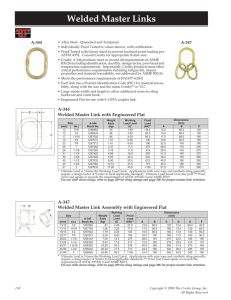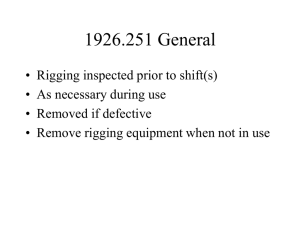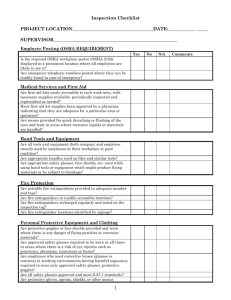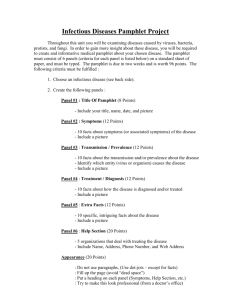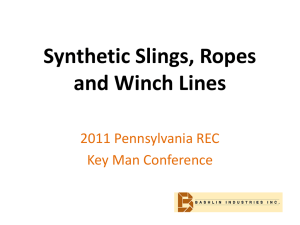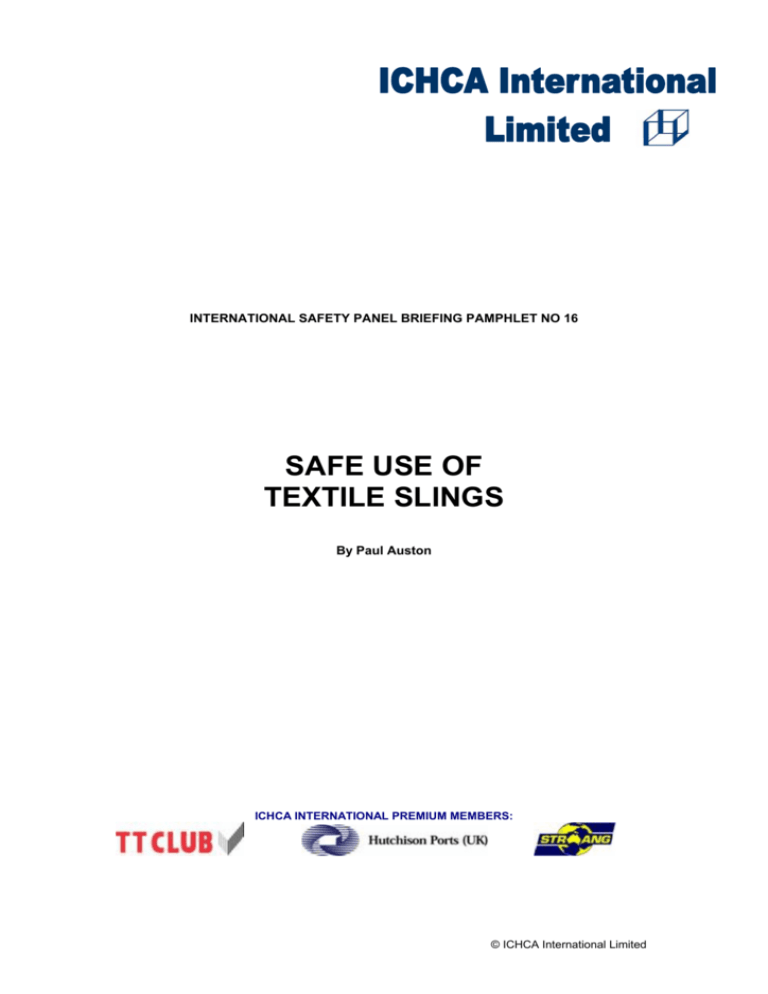
INTERNATIONAL SAFETY PANEL BRIEFING PAMPHLET NO 16
SAFE USE OF
TEXTILE SLINGS
By Paul Auston
ICHCA INTERNATIONAL PREMIUM MEMBERS:
© ICHCA International Limited
ICHCA INTERNATIONAL LIMITED is an independent, nonpolitical international membership organisation, whose
membership comprises corporations, individuals, academic
institutions and other organisations involved in, or concerned with,
the international transport and cargo handling industry.
With an influential membership in numerous countries, the
objective ICHCA International Limited is the improvement of
efficiency in cargo handling by all modes of transport, at all stages
of the transport chain and in all regions of the world. This object is
achieved inter-alia by the dissemination of information on cargo
handling to its membership and their international industry.
ICHCA International Limited enjoys consultative status with a
number of inter-governmental organisations. It also maintains a
close liaison and association with many non-governmental
organisations.
ICHCA International Limited has National Section Offices in
various countries, together with an International Registered Office
in the U.K., whose role it is to co-ordinate the activities of the
Company and its standing committees, i.e. the International Safety
Panel and Bulk Panel. The Registered Office maintains a unique
and comprehensive database of cargo handling information and
operates a dedicated technical enquiry service, which is available
to members and non-members.
Studies are undertaken and reports are periodically issued on a
wide range of subjects of interest and concern to members and
their industry.
ICHCA International Limited
Suite 2, 85 Western Road,
Romford, Essex, RM1 3LS
United Kingdom
Tel:
Fax:
Email:
Website:
+44 (0) 1708 735295
+44 (0) 1708 735225
info@ichcainternational.co.uk
www.ichcainternational.co.uk
© ICHCA International Limited
The International Safety Panel Briefing Pamphlet series consists of the following subjects:
International Labour Office (ILO) Convention No. 152 Occupational Safety and
Health in Dockwork
No. 2
Ships Lifting Plant
No. 3
The International Maritime Dangerous Goods (IMDG) Code (Revised)
No. 4
Classification Societies (Revised)
No. 5
Container Terminal Safety
No. 6
Guidance on the Preparation of Emergency Plans
No. 7
Safe Cleaning of Freight Containers
No. 8
Safe Working on Container Ships
No. 9
Safe Use of Flexible Intermediate Bulk Containers (FIBCs) (under revision)
No. 10
Safe Working at Ro-Ro Terminals
No. 11
The International Convention for Safe Containers (CSC)
No. 12
Safety Audit System for Ports
No. 13
The Loading and Unloading of Solid Bulk Cargoes
No. 14
The Role of the Independent Marine Surveyor in Assisting Claims Handling
No. 15
Substance Abuse
No. 16
Safe Use of Textile Slings
No. 17
Shore Ramps and Walkways
No. 18
Port State Control
No. 19
Safe Handling of Interlocked Flats
Other titles are in preparation
No. 1
The International Safety Panel Research Paper series consists of the following subjects:
No. 1
Semi-Automatic Twistlocks (under revision)
No. 2
Fumes in Ships Holds
No. 3
Health & Safety Assessments in Ports
No. 4
Container Top Safety, Lashing and Other Related Matters
No. 5
Port & Terminal Accident Statistics
No. 6
Safe Handling of Radioactive Materials in Ports and Harbour Areas
No. 7
Ship Design Considerations for Stevedore Safety
No. 8
Safe Walkways in Port & Terminal Areas
No. 9
Personal Protective Equipment & Clothing
Other titles are in preparation
The International Safety Panel Technical/Operational Advice series consists of the following:
No. 1
No. 1A
Vertical Tandem Lifting of Freight Containers
Vertical Tandem Lifting – Operations Checklist
This publication is one of a series developed by the International Safety Panel ("Safety
Panel") of ICHCA International Limited ("ICHCA"). The series is designed to inform those
involved in the cargo-handling field of various practical health and safety issues. ICHCA aims
to encourage port safety, the reduction of accidents in port work and the protection of port
workers' health.
ICHCA prepares its publications according to the information available at the time of
publication. This publication does not constitute professional advice nor is it an exhaustive
summary of the information available on the subject matter to which the
publication refers. The publication should always be read in conjunction with the
relevant national and international legislation and any applicable regulations, standards and
codes of practice. Every effort is made to ensure the accuracy of the information but neither
ICHCA nor any member of the Safety Panel is responsible for any loss, damage, costs or
expenses incurred (whether or not in negligence) arising from reliance on or interpretation of
the publication.
The comments set out in this publication are not necessarily the views of ICHCA or any
member of the Safety Panel
© ICHCA International Limited
All rights reserved. No part of this publication may be reproduced or copied without ICHCA's
prior written permission. For information, contact ICHCA's registered office.
© ICHCA International Limited
ICHCA International Limited - INTERNATIONAL SAFETY PANEL
The International Safety Panel is composed of safety and training officers and directors,
transport consultants, representatives from leading safety and training organisations and
institutions and leading authorities on the subject area from around the world.
Mike Compton (Chairman), Circlechief AP, UK
Bob Baron (Deputy Chairman), USA
John Alexander, UK
Paul Auston, Checkmate UK Limited, UK
David Avery, Firefly Limited, UK
Bob Barnes, Global Marine Systems Limited, UK
Ron D. Bird, Waterfront Training Services, NEW ZEALAND
Mike Bohlman, Horizon Lines, USA
Len Chapman, Ports Customs and Free Zone Corporation, UAE
Jim Chubb, BMT Murray Fenton Limited, UK
Richard Day, Transport Canada, CANADA
Hanneke de Leeuw, FEEPORT, BELGIUM
Capt. Kerry Dwyer, K. Dwyer & Associates Pty Limited, AUSTRALIA
Jamie Frater, P&O Ports, UK
Fabian Guerra, Fabian Guerra Associates, CANADA
Harri Halme, Min. of Social Affairs & Health, Dept for Occupational Health & Safety,
FINLAND
Graeme Henderson, Health & Safety Executive, UK
Jeff Hurst, Hutchison Ports (UK) Limited, UK
Peter van der Kluit, International Association of Ports & Harbors, THE NETHERLANDS
Larry Liberatore, National Safety Council, USA
Shimon Lior, Ports & Railways Authority, ISRAEL
Kees Marges, International Transport workers Federation, UK
Joachim Meifort, Hamburger Hafen-u Lagerhaus A-G, GERMANY
John Miller, Mersey Docks & Harbour Company, UK
Pedro J. Roman Nunez, Puertos del Estado, SPAIN
John Nicholls, TT Club, UK
Nic Paines, Confidence Shipmanagement Co. bv, THE NETHERLANDS
Captain Peter Lundahl Rasmussen, BIMCO, DENMARK
Risto Repo, Accident Investigation Bureau of Finland, FINLAND
Otto Rosier, National Ports Council, THE NETHERLANDS
Ron Signorino, The Blueoceana Company, Inc., USA
Armin Steinhoff, Behörde für Arbeit, Hamburg, GERMANY
Bala Subramaniam, Maritime Industries Branch, ILO, SWITZERLAND
Captain Beatrice Vormawah, International Maritime Organization, UK
Andrew Webster, TT Club, UK
Evert Wijdeveld, Environmental & Safety Affairs, Deltalinqs, THE NETHERLANDS
Jan Wubbeling, Wubbeling & Partners, THE NETHERLANDS
OBSERVERS:
Capt. Jim McNamara, National Cargo Bureau, Inc., USA
Charles Visconti, International Cargo Gear Bureau, Inc., USA
CORRESPONDING/ASSOCIATED MEMBERS:
Gerrit Laubscher, Estivar pty, RSA
Capt. Hans-Jürgen Roos, Port of Bremen, GERMANY
Paul Rossi, OSHA, USA
Hubert Vanleenhove, Hessanatie, BELGIUM
The above lists those persons who were members of the Panel when the pamphlet was
published. However, membership does change and a list of current members can always be
obtained from the ICHCA International Secretariat.
© ICHCA International Limited
International Safety Panel Briefing Pamphlet No 16
Checkmate Avon
Checkmate Avon consists of two specialist manufacturing divisions in the United
Kingdom. Textile lifting products based at Sheerness in Kent and Avon Fabrications
based at Melksham in Wiltshire, who specialise in the design, development and
production of specialist rubber fabrications, predominantly for the marine industry
and used on high speed craft throughout the world. The company holds ISO 9002
certification, in addition to Type approvals on its products from a number of
Classification Societies.
Paul Auston
Paul’s early career was at sea and when he came ashore took a position with a rope
manufacturing company based in Northern Ireland. This led to a lifelong fascination
with the use of synthetic fibres and their development into lifting materials. He set up
the company Checkmate of which he is now Chairman.
Acknowledgements
The author is indebted to a number of people throughout the world who have cooperated in the production of this briefing pamphlet: Richard Day, John Alexander,
Mike McKie, Rolf Stennes, Geoffrey Sowter, John Nicholls and Brian Dunn who
allowed me the use of his personal papers.
Finally, thank you to all whom, by virtue of my redundant memory cells, I have
forgotten to mention and without whose help and forbearance this publication would
not have been possible. For the record all the errors and mistakes are of my own
making.
Paul Auston
© ICHCA International Limited
International Safety Panel Briefing Pamphlet No 16
CONTENTS
Page
1
Introduction
1
2
Materials
2
2.1
2.2
2.2.4
2.2.5
2.2.6
2
2
3
4
4
3
Natural Fibres
Man Made Fibres
Nylon
Polyester
Polypropylene
Sling Configurations
4
3.1
3.2
3.3
3.4
4
6
7
7
Eye to Eye Slings (Strops)
Endless Slings
Parallel Construction Slings
Cloverleaf Slings
4
Storage of Textile Slings
8
5
Use of Textile Slings
8
5.1
5.2
5.3
5.4
5.5
Competent person
General
Eye to Eye Slings
Parallel Construction Slings
Cloverleaf Slings
8
8
12
13
13
6
Connection Points & Hooks
15
7
General Cargo Configurations
18
8
Pre-use Inspection
20
8.1
8.2
8.3
8.4
8.5
8.6
20
21
21
22
23
23
Competent person
General
Rope Slings
Webbing Products
Roundslings
Metal Fittings
9
Disposal
24
10
Legislation & Standards
24
10.9
25
One Trip Slings and Pre- Slung Cargo
Appendix 1
Countries that have ratified ILO 152
ISBN: 1 85330 100 0
978-1-85330-100-1
First published
2003
© ICHCA International Limited
International Safety Panel Briefing Pamphlet NO .16
Safe use of textile slings
1
INTRODUCTION
1.1
The previous ICHCA publication relating to slings was published in 1977
and was produced when the use of textile slings in a marine environment
was in its infancy. The last twenty years has seen a massive increase in
the use of textile slings, particularly when used for “pre-slinging” cargo, as
shippers, receivers, charterers and port handling organisations strive to
achieve the lowest possible operating costs.
1.2
In the same twenty-year period the use of slings made from natural fibres
has reduced to a very low figure. Their place has been taken by products
made from man-made fibres.
1.3
A number of new standards e.g. ISO 4878: 1981 “Flat woven webbing
slings made of man-made fibre” and PREN 1492-1:2000 “Textile slings –
Safety” have emerged. Many legal requirements have also changed. The
European Machinery Directive is now in force in all member states of the
European Union and applies to (amongst many things) slings.
1.4
This pamphlet takes into account these developments. It is not meant to
be exhaustive but can be considered as a reliable guide and will lead the
reader to other more detailed material where appropriate.
2
MATERIALS
1
© ICHCA International Limited
International Safety Panel Briefing Pamphlet NO .16
2.1
Natural fibres
2.1.1
Natural fibres used for slinging almost always take the form of three
stranded ropes, which may be formed into slings by the use of spliced
eyes. The two principal fibres in common use are sisal and manila.
2.1.2
Sisal is a fibre obtained from the leaf of a plant of the cactus family. It is
readily recognised by its characteristic hairy appearance and is rough to
the touch. Manila is a fibre obtained from the leaf of the plantain or wild
banana tree. Being a longer fibre than sisal, the resulting rope is less
hairy. It is also softer than sisal and, therefore, feels less rough to the
touch.
2.1.3
Both Sisal and Manila suffer from the effects of ultra violet light and will
become brittle if exposed to excessive amounts. Natural fibres are also
prone to attack by airborne organisms that will literally eat the fibre. One
of the most common organisms is mildew, which will thrive in warm
humid conditions. These organisms can severely reduce the breaking
strength of a fibre rope whilst appearing relatively harmless. Their use is
largely confined to specialist applications.
2.1.4
Other natural fibre ropes are available, such as Italian or Indian hemp,
jute and cotton. Their use is largely confined to specialised applications,
such as decorative ropes. Their use in the production of lifting slings is
negligible.
2.2
Man-made fibres
2.2.1
The principal materials available are polyamide (nylon), polyester and
polypropylene. These are all thermoplastic materials that will melt when
heated and re-solidify when cooled. This is a characteristic, which
enables them to be formed into various types of fibre by extrusion
processes.
2.2.2
Another recently developed material is para-aramid. Similar in many
ways to carbon fibre, this material possesses great tensile strength. It is,
however, very expensive and possesses some properties which are
undesirable for lifting slings. This generic group of materials is not yet
covered by any known standard.
2.2.3
An important consideration when choosing a material is the resistance of
that material to chemicals. Although it is not exhaustive the following
table gives an indication of the resistance of each material at 20oC.
2
© ICHCA International Limited
International Safety Panel Briefing Pamphlet NO .16
2.2.4
Nylon is the strongest of the generally available materials. It does
however possess properties that make it less desirable for lifting slings.
(a) It stretches substantially under load. Typically nylon will stretch
some 18% when loaded to its breaking point
(b) It loses some 10 – 20% of its tensile strength when it is wet.
(c) Temperature stability is generally good between –40oC and 100oC.
3
© ICHCA International Limited
International Safety Panel Briefing Pamphlet NO .16
2.2.5
Polyester is a close relative of nylon although slightly less strong. It does
not suffer from the excessive stretch of nylon. A typical extension to
breaking point is 10%. The strength of polyester does not deteriorate
when wet. Temperature stability is generally good between –40oC and
100oC.
2.2.6
Polypropylene is a less strong material than either polyester or nylon but
is still considerably stronger than natural fibres. It suffers substantially
from the effects of ultra violet light if exposed for long periods and needs
to contain suitable inhibitors to minimise this effect. Abrasion resistance
is superior to natural fibres but considerably inferior to nylon or polyester.
It is relatively cheap and a common application is the “one trip” or
disposable sling. The strength of polypropylene will be reduced if
exposed to high temperatures (80oC). Careful consideration should be
given to the use of polypropylene slings in a choke lift format, as
considerable heat can be generated should the choke slip.
3
SLING CONFIGURATIONS
3.1
Eye to eye slings
3.1.1
Eye to eye slings (strops) are the simplest type of sling that may be
formed from rope or webbing. In the case of rope, the eye is formed by
splicing.
3.1.2
Eyes are formed in webbing products by stitching. Single thickness
webbing slings will require stitching at each end whereas a double
thickness or duplex sling will have only one sewn joint. Webbing slings
may have flat, folded (becketed) or reversed eyes.
4
© ICHCA International Limited
International Safety Panel Briefing Pamphlet NO .16
3.1.3
Eyes of rope slings may incorporate a metal thimble to give added wear
resistance. This is essential if the eye is to be fitted with a shackle or
other metal end fitting.
3.1.4
The same objective may be achieved with webbing slings by the use of
metal end fittings.
3.1.5
Eye to eye slings are commonly used in choke or basket hitch (see
diagrams in section 7) for general, non specific dock work and are also
frequently used in conjunction with lifting frames or spreaders designed to
lift a specific load.
5
© ICHCA International Limited
International Safety Panel Briefing Pamphlet NO .16
3.2
Endless slings
3.2.1
Endless, or ring slings, are the most commonly used slings for marine
cargo handling. There are three basic types - rope, webbing or
roundslings.
3.2.2
Endless rope slings are formed by making a loop of rope and then
splicing it.
3.2.3
Webbing slings are formed by making a loop of webbing with a sewn
joint. For heavier applications webbing slings may be made with multiple
layers of webbing.
3.2.4
Roundslings are formed by making a continuous loop of fibre that is then
encased in a sleeve, which may be stitched along its edge or, more
commonly, will take the form of a tube, which is stitched where the ends
meet.
3.2.5
Endless slings may be used for pre-slung cargo operations in either
choke or basket hitch. It is likely, however, that the safe working load will
be given on the label of the sling and on the test certificate in the vertical
configuration only. Refer to mode factor adjustments in section 5.3.1.
3.3
Parallel construction slings
3.3.1
Parallel construction slings are used for very heavy cargoes. They are
normally constructed from duplex (double thickness) webbing laid side by
6
© ICHCA International Limited
International Safety Panel Briefing Pamphlet NO .16
side with smaller, lightweight, webbing of approximately 50mm width
used to join the heavier, load bearing, webbings. Separate eyes are
formed in each of the load bearing webbings and these normally
incorporate metal end fittings. Such slings are normally made for use in
basket hitch only and may vary in width from 300mm to more than
1200mm.
3.4
Cloverleaf slings
3.4.1
Cloverleaf slings are normally manufactured as one-trip slings i.e. they
are intended to remain with the cargo throughout its journey and should
be discarded after the cargo is delivered. The material used is usually
woven or extruded polypropylene, although in some cases polyester yarn
encased in a plastic sheath may be used. The centre section of the sling
forms a square with each crossover point being secured by stitching or
welding. The design of cloverleaf slings is specific to individual and
particular cargo types, as the dimensions of each sling are critical to its
lifting capability.
7
© ICHCA International Limited
International Safety Panel Briefing Pamphlet NO .16
4
STORAGE OF TEXTILE SLINGS
4.1
Storage conditions for textile slings should include protection from the
effects of extreme weather, the potential for mechanical damage and
accidental exposure to injurious factors such as heat, chemicals or
solvents.
4.2
A closed room or container that is kept at ambient temperature, with good
ventilation, is waterproof and excludes direct sunlight would be the
preferred choice of store.
4.3
Lifting slings should be clearly identified and, wherever possible, be
stored loosely laid on suitable racks or suspended from pegs or hooks.
They should not be kept on the floor where they may become damp and
then rot.
4.4
Any restrictions on the use of the slings should be shown. This will assist
the selection of the appropriate slings when required for use
5
USE OF TEXTILE SLINGS
5.1
A responsible person should inspect all slings before each period of use.
(See section 8.1).
5.2
5.2.1
General
The following is general advice applicable to all types of sling made from
all types of material.
5.2.2
Only use slings that are properly identified. (See section 4.3).
8
© ICHCA International Limited
International Safety Panel Briefing Pamphlet NO .16
5.2.3
Do not use damaged slings. Damage seen on the surface is the most
noticeable cause of potential weakness. Damage to splices, stitching and
metal fittings may also be present.
5.2.4
In order to achieve the correct balance of any packages to be lifted, it is
strongly recommended that two slings are used. These should be
positioned equally along the load to be lifted, with due regard for any
mode factor incurred (see section 5.3.1). In the event that such an
attachment is not possible, it is essential that the suspension point is
directly above the centre of gravity of the load. If it is not, the load may
swing violently when it is lifted, resulting in personal injury.
5.2.5
When using slings in choke hitch, allow the choke to form naturally. Do
not try to force the angle of choke by hammering or by other means.
9
© ICHCA International Limited
International Safety Panel Briefing Pamphlet NO .16
5.2.6
When using slings in choke hitch, position them symmetrically
5.2.7
Do not engage soft eyes with anything that may damage them. Bearing
surfaces must be smooth and without sharp edges.
5.2.8
Do not engage soft eyes with anything that will, due to its size, force the
eye apart. The included angle in the eye should not exceed 30o(see
diagram in section 6.5).
5.2.9
Do not drag loads by means of slings.
5.2.10
Do not lift with twisted slings.
5.2.11
Do not make knots in slings.
5.2.12
Fit protective sleeves or packing between slings and loads with sharp
edges.
10
© ICHCA International Limited
International Safety Panel Briefing Pamphlet NO .16
5.2.13
Do not trap slings when loads are set down as this may damage slings.
5.2.14
Do not pull slings from under loads when loads are resting on the slings.
5.2.15
Avoid snatch or shock loading.
5.2.16
Consider the effects of temperature, chemicals and other environmental
factors when choosing slings and deciding on the manner in which they
will be used.
5.2.17
Guide suspended loads manually, where possible, this should be done by
means of a “tag line” so that the person guiding the load is not likely to be
struck by it.
11
© ICHCA International Limited
International Safety Panel Briefing Pamphlet NO .16
5.2.18
Wear suitable personal protective equipment when engaged in lifting
operations i.e. gloves to protect hands from rough loads, safety boots and
protective headgear.
5.2.19
Do not attempt to repair damaged slings.
5.3
Eye to eye slings
5.3.1
In addition to the general advice in section 5.2, observe the mode factor
(M).
M=1
M=0.8
M=1.4
M=1.4 @ 90O
The mode factor is multiplied by the Working Load Limit (WLL) of a single
leg to give the WLL of the assembly
5.3.2
When using multi-legged slings or multiple slings to form a multi-leg
configuration, the included angle at the point of suspension should,
ideally, be greater than 60o but should not exceed 90o. Remember that as
the angle to the vertical of a sling leg increases the tension in that leg
12
© ICHCA International Limited
International Safety Panel Briefing Pamphlet NO .16
also increases and, if the angle is large enough, can exceed the value of
the total load being lifted.
Tension of legs in a two-legged sling
5.4
Parallel construction slings
5.4.1
In addition to the general advice in section 5.2 care needs to be taken to
ensure equal distribution of the load between the individual load bearing
webbings.
5.4.2
Parallel construction slings should only be used in basket hitch.
5.5
Cloverleaf slings
5.5.1
In addition to the general advice in section 5.2, cloverleaf slings should
only be used to lift loads for which they have been designed.
5.5.2
The cloverleaf loops must extend above the uppermost part of the load.
5.5.3
The loops should be bound to each other by means of a tie cord, as
shown below, to ensure that they remain in place when the load is set
down.
13
© ICHCA International Limited
International Safety Panel Briefing Pamphlet NO .16
5.5.4
Cloverleaf slings must not be handled with a forklift truck unless the forks
are fitted with round bar hook terminations, as shown below.
5.5.5
The main use of cloverleaf slings is for lifting bagged cargoes. Care
needs to be taken to ensure that there is friction between the outer
14
© ICHCA International Limited
International Safety Panel Briefing Pamphlet NO .16
surfaces of the bags and the sling, to ensure that the load does not shift
whilst being lifted or lowered.
6
CONNECTION POINTS AND HOOKS
6.1
Connection points of lifting appliances need to be strong enough to
support the load and be of such a size and shape that they do not
damage, or place extra stresses, on the slings. The most frequently used
connection is a single point crane hook although “ramshorn” hooks may
also be used and are desirable when more than two sling eyes are to be
accommodated.
6.2
Semi-automatic and purpose made hooks
6.2.1
Shippers involved in the regular handling of pre-slung cargo, utilising
webslings, have tended to use round bar hooks, with a shape similar to a
triangle, thus allowing the whole width of the sling, up to 4” (100mm) to
be laid along the bar equally. The stresses involved in the use of such a
hook led to the development of the semi-automatic hooks produced by
companies such as Cranston.
15
© ICHCA International Limited
International Safety Panel Briefing Pamphlet NO .16
6.2.2
These vacuum operated hooks, have a load bearing area that is radiused
to be web sling friendly and can in certain circumstances, accommodate
the full width of the sling, up to 4” (100mm).
6.3
The use of a “C” hook that is specifically designed to prevent snagging
and accidental displacement of the slings when loads are lifted, is an
acceptable alternative, although it should be stressed that for the
optimum in safe lifting any lifting device connecting with a sling should,
under ideal circumstances, be fitted with a safety latch to ensure that the
eye of the sling remains captive.
16
© ICHCA International Limited
International Safety Panel Briefing Pamphlet NO .16
6.4
Crowding of hooks should be avoided by placing no more than two eyes
on a hook (two on each side of a ramshorn). When more than two eyes
need to be accommodated, a shackle or ring should be used to join the
eyes together and the shackle or ring placed on the hook.
6.5
It is important that the bearing surface of the attachment point is smooth
and wide enough to support the eye of the sling. It must not be so wide
as to force the eye apart as this could severely weaken the eye by tearing
the stitching or the splice apart. The critical dimensions of suspension
points, with views at right angles to each other, are shown below.
6.6
For large or long loads a spreader or lifting frame may be used to achieve
a stable lift. The essential feature of these aids to safe lifting is that the
load is supported by slings attached to the spreader or frame, which is
then attached to the crane hook.
17
© ICHCA International Limited
International Safety Panel Briefing Pamphlet NO .16
6.8
When using 4-legged slings it is likely that at least one of the legs will not
take its fair share of the load. For this reason the W.L.L. is based on the
strength of 3 not 4 legs, and in some countries it is based on the strength
of only 2 legs.
7
GENERAL CARGO CONFIGURATIONS
7.1
The following diagrams illustrate commonly used safe methods of
handling different types of cargo. The common names of the different
types of hitch are shown.
18
© ICHCA International Limited
International Safety Panel Briefing Pamphlet NO .16
19
© ICHCA International Limited
International Safety Panel Briefing Pamphlet NO .16
8
PRE-USE INSPECTION
8.1
All lifting slings, including those attached to pre-slung cargo, should be
inspected by a competent person before each period of use.
20
© ICHCA International Limited
International Safety Panel Briefing Pamphlet NO .16
8.2
General
8.2.1
This section is not exhaustive and reference should be made to
appropriate standards and supplier’s literature.
8.2.2
All lifting slings should be properly identified with an identification
number, which permits traceability and relates to a test certificate or
declaration of conformity. The safe working load necessary is shown in
the vertical lift mode and should be clearly shown on each sling. For
other configurations refer to the mode factors in section 5.3.1 Each sling,
or batch of slings, should have the instructions for safe use that were
supplied with them made available to the user.
8.2.3
Colour coding of slings to indicate their working load limit and labels to
indicate the material from which the sling is made is commonplace.
However, as at September 2002, no internationally recognised colourcoding system exists and reference needs to be made to the supplier’s
literature or the appropriate standard. It should be remembered that a
significant number of people have a degree of colour blindness and a
label giving the W.L.L. in figures may also be needed
8.3
Rope slings
8.3.1
Pre-use inspection of slings should include checking for the matters listed
in 8.3 to 8.6 as appropriate.
8.3.2
Wear and chafing. In use some disarrangement or breaking of surface
fibres is to be expected. In the case of man made fibre ropes this will
raise a pile or fur on the surface of the rope. It is not a cause for concern
unless it is excessive or if the wear extends beneath the outer layer of
fibres.
8.3.3
Abrasion (External). Abrasion is a more substantial form of wear, which
may be localised. It may be caused by the sling rubbing against a sharp
edge whilst under tension. Only surface damage may be considered
acceptable.
8.3.4
Abrasion (Internal). Abrasive particles from cargoes or the
surroundings can enter the rope and cause internal abrasion. This can
only be detected by slightly opening the rope by twisting it against the lay.
8.3.5
Fraying. Fraying is usually an indication of cutting of the yarns or
strands and if found to be severe would cause concern.
8.3.6
Internal wear. Internal wear is caused by the ingress of abrasive
particles, such as grit, getting into the rope. It is characterised by the
presence of fibre dust. If severe, the strands of the rope will become
loose.
8.3.7
Mildew. Mildew is caused by use or storage of natural fibre products in
damp stagnant conditions and the presence of a mould, which lives on
the cellulose, within the material. It has a characteristic smell and can
severely weaken natural fibres despite looking innocuous. Mildew may
occur on the surface of man-made fibre products. In this case it can be
washed off with clean water. Detergents should not be used as these can
damage the material of the sling.
21
© ICHCA International Limited
International Safety Panel Briefing Pamphlet NO .16
8.3.8
Chemical attack. Natural fibre products should not be assumed to be
resistant to any chemical. Man made fibres will resist chemicals
selectively. The correct material needs to be chosen if exposure to
chemicals is likely. Chemical attack will often soften or embrittle the
fibres, which can then be rubbed or plucked from the rope. Sling that
have become contaminated should be soaked immediately in several
changes of clean, cold water. It should be noted that contamination of a
dilute nature may concentrate as the sling dries out and its effect on the
sling strength may become more serious.
8.3.9
Heat damage. Charring in natural fibres and the fusing or glazed
appearance of man-made fibres is evidence of heat damage. It may
result from an external source or may be the result of friction, for example
when slings are carelessly used in choke hitches.
8.3.10
Solar Degradation (Ultra-Violet Light). Ultra violet light causes fibres to
become brittle. Accidents have been reported where unstable material
has been used in the sling manufacture. It is not possible to detect the
presence of a suitable ultra-violet stabiliser in the sling material by visual
inspection. Generally, polyester and nylon have good resistance to ultraviolet but polypropylene can degrade very quickly unless a suitable
stabiliser has been added at the time of manufacture. Where doubt
exists obtain information from the manufacturer/owner before use.
8.3.11
Heavy Soiling. Although some soiling in use is inevitable, heavy soiling
may obscure the identification or colour coding of the sling. Soiling may
also act as an adhesive for grit and other abrasive particles and may soil
the cargo. Washing with clean water will remove some soiling but if it is
oil based, water will not remove it. No attempt should be made to clean
soiled products with solvents.
8.4
Webbing products
8.4.1
Surface Chafing. This is normal. If confined to the surface fibres as
opposed to the yarns it has no serious effect. If the outer yarns of the
webbing are severed this will severely weaken the slings.
8.4.2
Local Abrasion. Local abrasion can be severe and may result in serious
loss of strength.
8.4.3
Cuts. These may occur, either longitudinally or laterally, in the webbing
and will result in loss of strength. Cuts at the edge of the webbing will
result in serious loss of strength even though the cut may look
insignificant.
8.4.4
Chemical Attack. Man made fibres will resist chemicals selectively. The
correct material needs to be chosen if exposure to chemicals is likely.
Chemical attack will often soften or embrittle the fibres, which can then be
rubbed or plucked from the sling.
Heat damage. Fusing or glazed appearance of man-made fibres is
evidence of heat damage. It may result from an external source or be the
result of friction, for example when slings are carelessly used in choke
hitches.
8.4.5
.
22
© ICHCA International Limited
International Safety Panel Briefing Pamphlet NO .16
8.4.6
Damaged Stitching. This should be regarded as a potential cause of
severe loss of strength no matter how insignificant it may appear. In
duplex construction slings, where the stitching is not load-bearing on the
plied material, stitch damage is less critical. In such cases the
manufacturer’s advice should be obtained.
8.4.7
Loose webbing. Webbing can become loose and soft to the touch so
that the weft can be moved or separated easily, this can have a serious
effect on the strength of slings.
8.4.8
Heavy Soiling. Although some soiling in use is inevitable, heavy soiling
may obscure the identification or colour coding of the sling. Soiling may
also act as an adhesive for grit and other abrasive particles and may soil
the cargo. Washing with clean water will remove some soiling but if it is
oil based, water will not remove it. No attempt should be made to clean
soiled products with solvents.
8.5
Roundslings
8.5.1
Exposed Core. Some scuffing and wear of the protective sleeve is to be
expected but on no account should this be so severe as to expose the
load bearing core of the sling.
8.5.2
Cuts. Cuts in the protective sleeve will expose the core and are not
acceptable.
8.5.3
Damaged Stitching. Any damage to stitching must be regarded as a
potential for serious loss of strength.
8.5.4
Heat Damage. Damage to the sleeve, and a glazed appearance, if due to
friction, may indicate serious heat damage to the load-bearing core. Any
heat damage that causes penetration of the outer sleeve is serious.
8.5.5
Chemical Attack. This may be difficult to detect. Knowledge of previous
use is desirable. There may be some discolouring of the sleeve but the
underlying load-bearing core is not visible. It may be necessary to err on
the side of caution and discard any slings that look as though they may
have suffered attach from chemicals.
8.6
Metal fittings
8.6.1
Metal end fittings should be inspected for signs of mechanical damage,
corrosion or significant distortion. Apart from being an indication of abuse
in a previous use or during storage, such defects may damage the body
of the sling when it is next used.
9
DISPOSAL
9.1
When a sling has reached the end of its useful life it must be disposed of
carefully and properly. It is not acceptable to throw it on the nearest
rubbish heap. It should be rendered useless by cutting through the sling
to prevent further use by a third party.
23
© ICHCA International Limited
International Safety Panel Briefing Pamphlet NO .16
9.2
Since most slings are manufactured from thermoplastic material they may
need to be disposed of by a licensed, or authorised, waste contractor.
Incineration should not be carried out unless it is the only form of disposal
allowed. Only experienced contractors with the appropriate equipment
should carry out incineration because toxic gases are released during
burning.
10
LEGISLATION AND STANDARDS
10.1
It should be appreciated that legislation and standards, although often
closely allied, are different things. Legislation has the backing of the
force of law whereas standards are voluntary codes of practice. In many
cases compliance with a recognised standard will be accepted in a court
of law as satisfying legal requirements.
10.2
Legislation varies from country to country. Within the European Union,
national law is increasingly becoming a reflection of European directives.
One such example is the European Machinery Directive, which lays down
essential safety requirements (ESRs) for the products that it covers. As
slings are classified as machines in the directive, they are subject to its
requirements. These include a factor of safety of 7:1 for textile slings. In
the absence of a harmonised standard (see 10.3 and 10.4), the directive
does not require the issue of a test certificate but demands a “declaration
of conformity”. This is a document issued by the supplier that certifies that
the product meets the ESRs in question. In addition, any product that
warrants a declaration of conformity must be “CE” marked. For textile
slings the “CE” mark usually appears on the label. The directive also
requires that a supplier issues instructions for the care and safe use of
the product.
10.3
European standards or euro norms as they may be referred to, are
gradually replacing national standards. Harmonised standards, in this
context, are those that have been prepared to address the requirements
of a European directive and, therefore, a product made in compliance
with such a standard is deemed to comply with the ESRs of the relevant
directive(s).
10.4
In areas outside Europe, the European Machinery Directive is of no direct
consequence although it may be regarded as a useful “Code of Practice”.
10.5
This raises the question of what regulations apply to slings on a ship from
outside Europe operating in a European port. Schedule 5 of the
European Machinery Directive excludes from the application of the
directive, equipment on board ocean-going ships. Such equipment is
known as “ships’ equipment”.
10.6
There is no agreed standard that can be universally applied but it is
useful to note that ISO 4878; 1981, which was withdrawn in November
2000, has been adopted by the following countries: Australia, Belgium,
Bulgaria, Canada, Cyprus, Czechoslovakia, Egypt, Finland, Ghana,
Indonesia, Israel, Italy, Japan, Korea, Republic of, Netherlands, New
Zealand, Norway, Poland, Portugal, Romania, South Africa, Spain,
Sweden and Switzerland. This standard may enable those responsible
for the safe unloading of pre-slung cargo to make an informed judgement.
24
© ICHCA International Limited
International Safety Panel Briefing Pamphlet NO .16
10.7
When ships are to be loaded, using pre-slung cargo, the Master should
be presented with the appropriate test certificates / certificates of
conformity before loading commences. As a minimum, these should
certify that the slings meet the requirements of ISO 4878; 1981, or
national legislation or standards of the loading country. All slings should
be traceable to their certificates. The Master should retain the
documentation for presentation at the port of discharge. Where special
procedures are in force for the handling of pre-slung cargo the Master
should hold a current copy of those procedures.
10.8
When unloading, the situation is a little more complex. Often the first sight
of the slings is when the hatches are opened and stevedores /
longshoremen are under pressure to unload the ship as quickly as
possible. Legislation within Europe, North America, Australia, New
Zealand, Japan, South Africa to name but a few, requires employers to
provide safe systems of work and equipment that is fit for purpose. The
use of any equipment before firstly seeing a valid certificate conforming to
International Labour Office Convention 152 may, in the event of an
accident, be considered to be contributory negligence. It is, therefore,
essential to ensure that equipment to be used for discharging the cargo is
safe to use. In the absence of a test certificate, a competent person
should examine the slings and, if appropriate, make a trial lift before
allowing operations to proceed. Ultimately, advice may be sought from
the relevant port state occupational safety enforcement authority and/or
from the rigging community, often to be found close to any port or
terminal operation
10.9
One trip slings and pre-slung cargo
10.9.1
One-way slings/ disposable slings/ one trip slings have gained immense
popularity for spot-cargo requirements in recent years. The author cannot
pretend that he is anything other than baffled by the “regulations” he has
seen imposed in various places throughout the world, covering this type
of equipment.
10.9.2
Use of one-trip disposable slings that are designed for specific cargo
should be the subject of discussion and agreement, between the
consignor, vessel operators and the consignee. They should consider the
route that the pre-slung cargo is intended to take. However, the ship may
be compelled to alter route then consideration of other National
regulations may be required. In meeting whatever requirements apply,
the manufacturer should enjoin the other parties to ascertain by what
means of sampling and/or testing, he can ensure that the method used
and the certification provided, will meet the regulations which apply at all
points and stages, where the cargo will be loaded and/or unloaded. The
requirement that one-trip slings must be destroyed at the final destination
is a matter of enforcement. There is an increasing concern that this is
done in an environmentally friendly manner. This lends itself to the use of
readily disposable and/or biologically degradable materials. This
presumes that such materials are suitable for the marine environment in
which they will be predominately used.
10.9.3
The International Labour Office has confirmed that the second edition of
the ILO code of practice “Safety & Health in Dockwork” (ISBN 92-2-
25
© ICHCA International Limited
International Safety Panel Briefing Pamphlet NO .16
101593-9) fifth impression 1997 is current at the time of printing. The
following extracts from section 22.3 of the code of practice may be helpful
in the decision making process:
a)
The width of the belt should be not less than 25mm
b)
The declaration required under subparagraph 22.1 (a) should state
the sling would not break at less than five times its safe working
load, in the case of a belt width from 25mm to 50mm and at less
than four times its safe working load in the case of belt width of
50mm and above.
c)
The declaration referred to is a certificate containing a declaration
by the manufacturer, of the safety factor in relation to the safe
working load, the safe working load in straight lift, the distinguishing
mark of each sling to relate it to the certificate. The belt and
stitching material from which the sling is made and marked to
indicate that it has been made to an approved standard.
d)
The sling should be marked in a suitable place in such a way, that it
would remain legible throughout the life of the sling, with the
following information:
1. Its safe working load 0o to 60o
2. Either the mark “U” indicating a disposable sling, or the word
disposable” in English and in the language of the country
where it will be taken off the load.
3. The maker’s identification.
4. A batch number including reference to its year of manufacture.
10.9.4
As can be seen the ILO refers to standards, it may be helpful to consider
at this point, the British Standard 3481:1970 (Part 3),
10.10
Further advice on both re-usable and one-way slings may be obtained
from specific rules and standards relevant to specific countries. Some of
these are described below:
10.10.1
Australia. - Standards enshrined in Marine Order Part 32 dated February
1998, as follows: Slings Fibre ASI 1380 - 1972
Synthetic webbing ASI 1353 - 1990
Roundslings Synthetic fibre ASI 4497 - 1997
10.10.2
Canada. - The Canadian coastguard standard requires a minimum factor
of safety of 6:1 for re-usable slings. Additionally, the factor of safety for
older slings is defined by reference to a wear standard and there are
provisions for testing of slings to establish a “manner of use”
10.10.3
U.S.A. - ASME BE30.9-1990 specifies design factors for synthetic
webbing slings.
10.10.4
New Zealand. - Whilst national standards exist they are in the main a
reflection of ISO 4878; 1981 and BS 3481. The same is true of Japan.
10.10.5
Russia (as opposed to USSR). - Has imposed a factor of safety of 9:1 for
industrial products. It would seem however that they continue to comply
with ISO 4878; 1981, which was confirmed by the USSR for marine
environments.
10.10.6
Legislation in various parts of the World may change rapidly and this
booklet cannot be considered definitive. It attempts to advise on good
26
© ICHCA International Limited
International Safety Panel Briefing Pamphlet NO .16
practice and refers to sources of legislation and standards known to the
author. For a specific application, it is wise to seek the advice of a
reputable manufacturer who will provide appropriate information and
training and offer the added comfort of worldwide product liability cover.
27
© ICHCA International Limited
International Safety Panel Briefing Pamphlet NO .16
Appendix 1
The following countries have ratified ILO 152.
Brazil
Congo
Cuba *
Cyprus
Denmark *
Ecuador
Egypt
Finland *
France *
Germany
Guinea
Iraq
Italy *
Mexico *
Netherlands *
Norway *
Peru
Spain *
Sweden
Tanzania
* These countries had previously ratified ILO 32
© ICHCA International Limited

